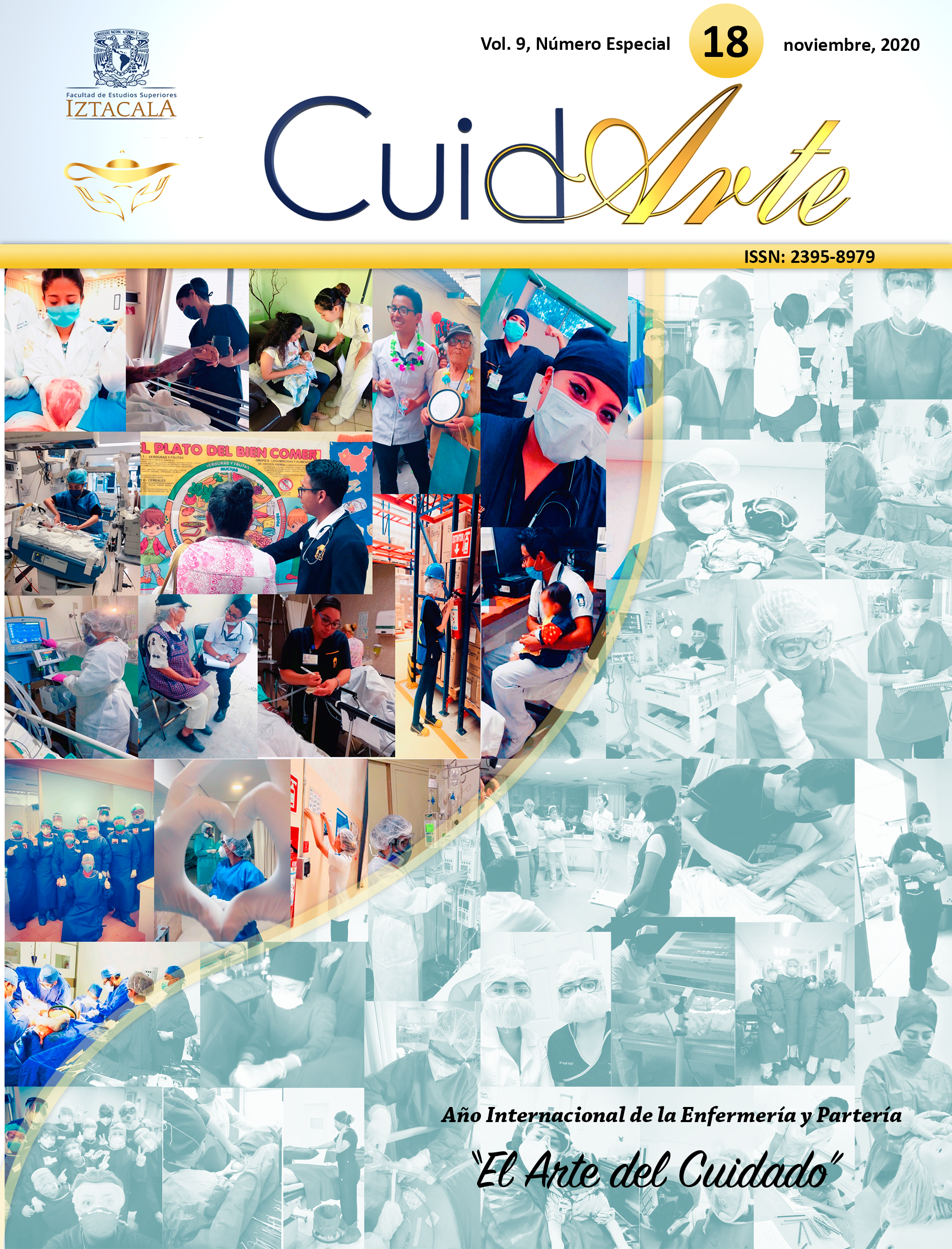The silent leadership of nursing in Mexico: reflections on its transformation
Main Article Content
Abstract
Downloads
Article Details
References
(1). Secretaría de Salud. Estado de la enfermería en México. OPS, OMS. [Sitio de internet] 2018 [Consultado: 12 mayo 2019]. Disponible en: https://bit.ly/2UDYesB
(2). Nigenda G. Compilador: Enfermería y sistemas de salud en México. Ciudad de México: UNAM. En prensa. 2020.
(3). Comité Promotor por una Maternidad Segura en México. El estado de las parteras en el mundo. [Sitio de internet]. 2014 [Consultado: 20 mayo 2020]. Disponible en: https://bit.ly/3ixQgtB
(4). Radsma J. Caring and nursing: a dilemma. Journal of Advanced Nursing [Internet] 1994 [Consultado: 21 mayo 2020]; 20(3): 444-449. DOI: https://doi.org/10.1111/j.1365-2648.1994.tb02379.x
(5). Reid L. Scientism in Medical Education and the Improvement of Medical Care: Opioids, Competencies, and Social Accountability. Health Care Anal. [Internet]. 2018 [Consultado: 10 marzo 2020]; 26(2): 155-170. DOI: 10.1007/s10728-017-0351-9
(6). Mariñez F. La dimensión relacional del gobierno abierto y el liderazgo colaborativo. Espiral (Guadalajara). [Internet]. 2016 [Consultado: 20 mayo 2020]; 23(65): 47-87. Disponible en: https://bit.ly/2Y42IJP
(7). Aristizabal P, Nigenda G, Squires A, Rosales Y. Regulación de la enfermería en México: actores, procesos y resultados. Ciênc. saúde coletiva. [Internet]. 2020 [Consultado: 17 junio 2020]; 25(1): 233-242. DOI: https://doi.org/10.1590/1413-81232020251.28462019.
(8). Johnsons CS, Smith CM. Preparing Nurse Leaders in Nursing Professional Development. Legal and Ethical Issues for Nursing Professional Development Leaders. J Nurses Prof Dev. [Internet] 2018 [Consultado 19 junio 2020]; 34(4); 226-227. DOI: 10.1097/NND.0000000000000442
(9). Bodine JL. Preparing Nurse Leaders in Nursing Professional Development: Association for Nursing Professional Development Leadership Academy. J Nurses Prof Dev [Internet] 2019 [Consultado 20 junio 2020]; 35(6): 351-353. DOI: 10.1097/NND.0000000000000584
(10). Dent M. Remodelling hospitals and health professions in Europe: Medicine, nursing and the state. Londres: Palgrave Macmillan; 2003.
(11). Evetts J. A new professionalism? Challenges and opportunities. Current sociology. [Internet]. 2011. [Consultado: 16 marzo 2020]; 59(4): 406-422. DOI: https://doi.org/10.1177/0011392111402585
(12). Salminen L, Stolt M, Saarikoski M, Suikkala A, Vaartio H, Leino-Kilpi H. Future challenges for nursing education–A European perspective. Nurse education today. [Internet] 2010 [Consultado: 20 junio 2020]; 30(3): 233-238. DOI: 10.1016/j.nedt.2009.11.004
(13). Humar L, Sansoni J. Bologna Process and Basic Nursing Education in 21 European Countries. Ann Ig [Internet]. 2017;29(6):561–71. Available from: https://www.ncbi.nlm.nih.gov/pubmed/29048453
(14). Squires AP. A case study of the professionalization of Mexican nursing: 1980 to 2005 [Tesis doctoral]. United States: Universidad de Yale, 2007. Disponible en: https://bit.ly/3gXhvwk
(15). Zug KE, de-Bartoli SH, Pulcini J, Garcia AB, Aguirre-Boza F, Park J. Advanced practice nursing in Latin America and the Caribbean: regulation, education and practice. Revista latinoamericana de enfermagem. [Internet] 2016 [Consultado: 15 febrero 2020]; 24: e2807. DOI: http://dx.doi.org/10.1590/1518-8345.1615.2807.
(16). “Para la atención de la mujer durante el embarazo, parto y puerperio y de la persona recién nacida” NORMA Oficial Mexicana NOM-007-SSA2-2016. Diario Oficial de la Federación, 17 de febrero de 2016.
(17). De-Bortoli B, et al. The situation of nursing education in Latin America and the Caribbean towards universal health. Revista latino-americana de enfermagem. [Internet] 2017 [Consultado: 14 marzo 2020]; v.25: e2913. DOI: 10.1590/1518-8345.2232.2913
(18). Nigenda G, Elliott P, Flores H, Aristizabal P, Martínez-Davalos A. Interprofessional training for the delivery of community health services in Mexico: the experience of Partners in Health. Journal of Interprofessional Care [Internet] 2019 [Consultado: 28 marzo 2020]; 33(4): 382-388. Disponible en: https://doi.org/10.1080/13561820.2019.1641475
(19). Bourgeault IL, Maier C, Dieleman M, Ball J, MacKenzie A, Nancarrow S, Nigenda G, Sidat M. Why has it taken this pandemic for all of us to more explicitly value our health workers? Commentary. Submitted to Human Resources for Health. 2020.
(20). Rivera-Dommarco J, et,al. Salud pública y atención primaria: base del acceso efectivo a la salud de los mexicanos. Cuernavaca: INSP, 2018. [Consultado: 7 julio 2020]. Disponible en: https://bit.ly/2F93uhN
(21). Diario Oficial de la Federación. Acuerdo por el que se emiten lineamientos que contienen el procedimiento y los criterios a los que deberán sujetarse los licenciados en Enfermería, así como los pasantes en servicio social de las carreras referidas en los numerales 1 al 5, del artículo 28 Bis, de la Ley General de Salud, para la prescripción de medicamentos. [Sitio de Internet] [Consultado: 8 marzo 2020] Disponible en: https://bit.ly/2E3czbp
(22). Rojas R. Por primera vez en la historia una enfermera podrá ser directora de las UMF del IMSS. [Sitio de internet] 2020 [Consultado: 7 julio 2020]. Disponible en: https://bit.ly/2PM2rq6
(23). Organización Mundial de la Salud. La salud es un derecho humano fundamental. Día de los Derechos Humanos 2017. [Sitio de Internet] [Consultado: 10 febrero 2017]. Disponible en: https://bit.ly/2DZZj7o
(24). East L, Knowles K, Pettman M, Fisher L. Advanced level nursing in England: organisational challenges and opportunities. Journal of nursing management [Internet] 2015 [Consultado: 12 junio 2020]; 23(8): 1011-1019. DOI: https://doi.org/10.1111/jonm.12247

